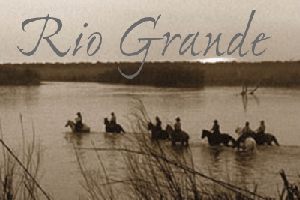


MARCH 1—JULY 31, 2005
RIO GRANDE: The Storied River
SOUTHWESTERN WRITERS COLLECTION
The grand waterway is celebrated in this exhibition that coincides with Jan Reid's anthology, Rio Grande, published by the University of Texas Press. Manuscripts, photographs, and music from the collection’s holdings present portraits of life along the river. Featured writers include John Graves, Dagoberto Gilb, Cecilia Ballí, Rolando Hinojosa-Smith, Dick J. Reavis, Stephen Harrigan, Joe Nick Patoski, Gary Cartwright, and Jan Reid.
A special panel discussion on Rio Grande is set for April 7, moderated by Jan Reid, with Cecilia Ballí, Dagoberto Gilb, Rolando Hinojosa-Smith, and Dick J. Reavis.
The Rio Grande’s narrative is like the silt of its bottomlands and delta-a complex layering of many locales and traditions. The river belongs to two countries, and as a consequence it is protected and managed by neither. It is a broken river now, overused and abused and in peril. Yet still it glows, emerald-like, in a collective imagination. And that mystique is its best hope for salvation.
—JAN REID, from Rio Grande
Back before there were customs checkpoints and border guards, before nations and national sovereignty, the Rio Grande sliced through a cluster of desert mountains and created a valley that would in time birth one of the most densely populated border regions in the world. Today, the cities of Ciudad Juarez and EI Paso stare at each other across an international line. Their relationship is defined by both allegiances and antagonisms; some days they feel they are one and the same, while others they sit in silence, refusing to speak. But for the past ten years, they have shared a common mystery. Neither side fully understands how it is that Juarez became such a dangerous place for women to live. Today it is a city where females disappear silently, every day, and then reappear in desolate corners-their bones exposed in the blazing sun, their skin black and dry as cardboard.
—CECILIA BALLÍ, from “Ciudad de la Muerte”
The Lower Valley road they traveled was paved two-lane but Mickey didn't see it that way because of the dust rising up from it, the tumbleweeds reeling across like drugged roadrunners: In the West is where they were. Where Billy the Kid was supposed to be locked up, where John Wesley Hardin twirled a pistola and dealt cards, where Pancho Villa lived forever and Pershing became a street downtown. And out here at dusk this day, the whoosh from a storm chasing after the setting sun, snapping branches and shadows off the cottonwoods and electrical poles, they drove by the Mexico-style adobes from then that were still now-or if not, which sure looked like they were-called auto parts and liquor stores, fereterias and supermercados. The land was still a flat, romantic brown, the light-skinned desert sand swirling around a single ocotillo or cholla or yucca on one side of the street, the darker plowed loam on the other, in the reach of the once-wider, fertile Rio Grande, planted with cotton or alfalfa or chile.
—DAGOBERTO GILB, from The Last Known Residence of Mickey Acuña
Both aliens had been told that La Migra’s men come with rifles for shooting rabbits along the route. Both had also heard reports from Mexicans who had dodged bullets along the road, like rabbits. The two immigrants crossed over the road and went into the brushland behind. Then they headed westward, ducking mesquite branches and trampling huisache underfoot. Thirty minutes ahead, Pelón had told them, they would run into an irrigation canal. They were to follow it until it came to a paved road, then they were to cross the road. After that, they would spot a series of radio towers with red lights to the northeast. They were to follow the lights to San Antonio, a walk about six nights long.
—DICK J. REAVIS, from Without Documents
But a place is merely that until it is populated, and once populated, the histories of the place and its people begin. For me and mine, history began in 1749 when the first colonists began moving into the southern and northern banks of the Rio Grande. That river was not yet a jurisdictional barrier and was not to be until almost one hundred years later; but, by then, the border had its own history, its own culture, and its own sense of place: it was Nuevo Santander, named for old Santander in the Spanish Peninsula. The last names were similar up and down both banks of the river, and as second and third cousins were allowed to marry, this further promulgated and propagated blood relationships and that sense of belonging.
—ROLANDO HINOJOSA, from “A Sense of Place”
- Facebook
- Twitter
- Instagram
- Youtube
Email List